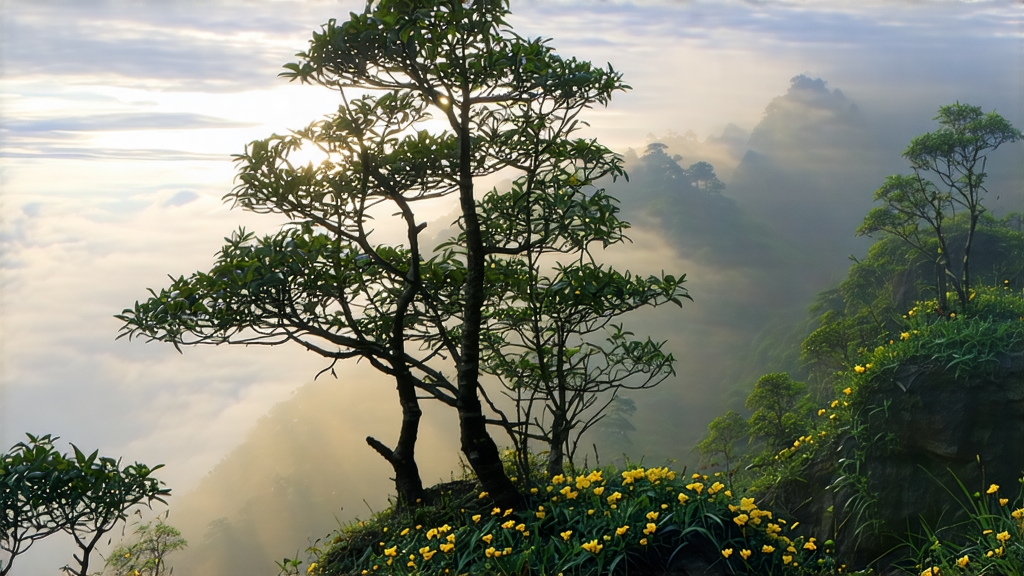
Hidden among the cloud-veiled peaks of Sichuan’s Mt. Meng, Meng Ding Huang Ya—literally “Meng Ding Yellow Bud”—has been whispering its mellow secrets for more than twelve centuries. To most Western drinkers “yellow tea” is still a colour on the supermarket shelf, yet this bud-only rarity once travelled the Min River in bamboo rafts, entered the Tang palace by imperial decree, and was poured for poets who compared its liquor to “the first moonlight on a jade well.” Today only a few hundred kilos leave the mountain each spring, making it the perfect ambassador for an almost-lost Chinese category that sits stylistically between green and white teas.
History: from palace to near extinction
The first written record appears in the 8th-century Classic of Tea where Lu Yu praises “the yellow shoot of Meng Mountain, sweet and clear as dew.” By Song times local magistrates froze the buds in silver-foil cylinders for the 1 300 km journey to Kaifeng; Ming scholars coined the term huang cha to distinguish its warm golden colour from the grassy greens then in vogue. When Qing emperors shifted their taste to fragrant green teas, Meng Ding Huang Ya lost its courier horses and almost its craft: the 1950 census listed only three ageing masters who still knew the secret “sealed yellowing” step. A state-sponsored restoration project in 1972 saved the cultivar, yet even now fewer than thirty families produce the authentic bud grade, plucked between Qingming and Grain Rain when two leaves sheath a single downy tip.
Micro-terroir: why the mountain makes yellow
Mt. Meng rises 1 450 m where the Sichuan basin meets the Tibetan plateau; warm daytime valley air meets cold Himalayan draughts after sunset, creating a 10 °C diurnal swing that stalls leaf growth and concentrates amino acids. The red-yellow sandstone soil is rich in selenium and copper—trace minerals that later catalyse the yellowing reaction—while 80 % humidity under perpetual cloud cover keeps fresh buds turgid during the long, slow with unique to yellow tea manufacture.
Craft: the six stages that turn green into gold
- Picking: only the “flag-and-one-leaf” shoot, 2–2.5 cm long, is taken before 9 a.m. while dew still protects cell turgor.
- Sha Qing (kill-green): buds are tumble-panned for 90 s at 140 °C on a cast-iron slope, just enough to denature polyphenol oxidase but preserve a faint enzymatic spark.
- Initial roll: light hand-pressing for 3 min fractures cell walls without breaking the epidermis, setting up internal channels for moisture migration.
- Men Huang—“sealed yellowing”—the hallmark step. The leaf is wrapped in steamed Meng bamboo sheaths, stacked in 5 kg heaps, and left for 48 h at 32 °C and 85 % RH. In this oxygen-starved micro-fermentation chlorophyll degrades to pheophytin, catechins dimerise into theaflavins, and a honey-like aroma precursor (DMHF) rises ten-fold.
- Low-temperature roast: charcoal embers at 60 °C dry the leaf to 20 % moisture; masters listen for the “sound of rain on paper” as buds gently snap.
- Final rest: three weeks in unglazed clay jars allows residual moisture to equalise; the tea emerges the colour of antique ivory, with a downy tip that smells of fresh corn silk and orchid.
Grades & styles
Imperial Bud (特级黄芽): 100 % single tips, liquor the colour of chardonnay, yields five infusions.
Fine Shoot (一级黄小芽): one leaf and a bud, more chestnut notes, good for three infusions.
Rain Bud (雨前黄芽): picked after Grain Rain, broader leaf, brisk and slightly peppery, priced at a third of the imperial grade.
Brewing: the gongfu of gentleness
Because yellow tea retains active enzymes, water above 90 °C will “cook” the buds and flatten aroma. The classic Sichuan method uses a tall cylindrical glass called meng shan bei so the vertical dance of buds can be observed.
Ratio: 3 g per 120 ml
Water: 85 °C, low-TDS spring water
Rinse: none;